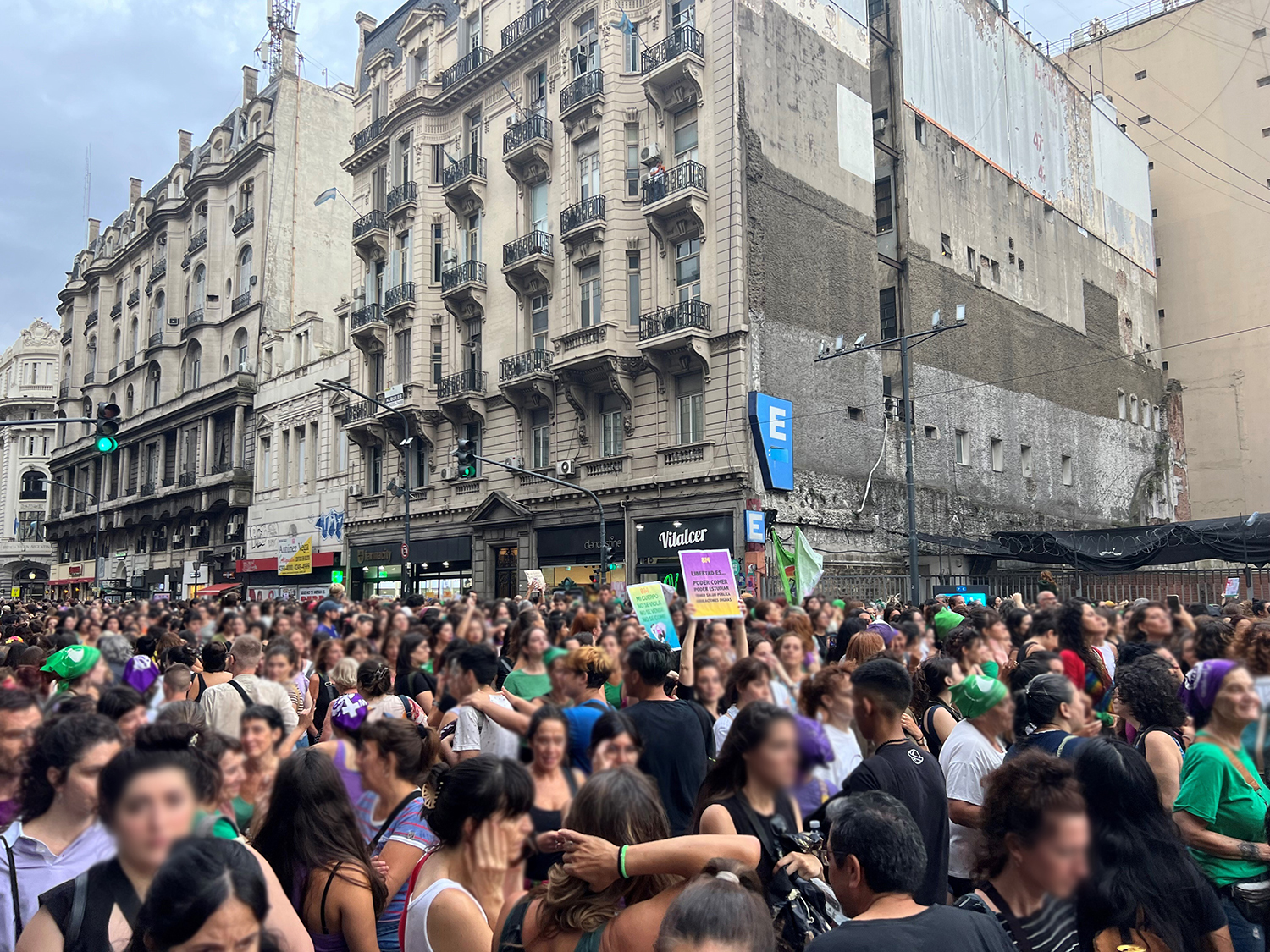The power of art: a shocking chant that spread worldwide “the rapist is you”
Latin America, including Chile, has historically been a deeply patriarchal region. Catholicism played a role in reinforcing that structure. While somewhat different from male chauvinism, a tradition rooted in machismo or male supremacy, upholding beliefs like “men should protect women” and “women should quietly obey men,” has existed for 500 years.
As a result, women as a minority have suffered from various forms of gender inequality. For instance, women were humiliated during police interrogations or blamed for being sexually assaulted with remarks like, “You shouldn’t have dressed like that,” or “It’s your fault for walking down that street.” They were oppressed simply for being women.
In response to such situation, in 2018, four artists, including performing artists and designers, formed Las Tesis in the Chilean city of Valparaíso. They began presenting performances protesting patriarchy and violence against women.
Then, in October 2019, the next year, a hike in subway fares triggered large-scale demonstrations in Chile. People who were dissatisfied with the societal situation such as the widening gap between the rich and poor, spontaneously started an anti-government and democratization movement in the capital, Santiago.
Riots, including Molotov cocktail attacks on train stations, continued, prompting President Sebastián Piñera to declare a state of emergency. He transferred public security authority to the military forces, initiating actions that oppressed the civilian population. This treatment, reminiscent of the 1974-1990 military regime under President Augusto Pinochet seemed to further deepen public resentment. Clashes between demonstrators and the military intensified, and even a fatal arson incident occurred.
In response to this trend, Las Tesis launched a performance art piece in the capital Santiago that combined rhythmic chanting with choreography resembling gestures. The chant, which translates literally as “the rapist is you,” accused patriarchy, machismo, and entrenched power structures of enabling violence against women. Their performance included blindfolds, shouted chants, and reenactments of degrading scenes, such as being forced to do naked squats during interrogations. They expressed the current status of Chile, where women were mistreated simply for being women. Although the first performance involved only about 50 participants, as some women arrested for the democratization movement were being subjected to degrading treatment, the circle of resonance has expanded.
On 25 November, the International Day for the Elimination of Violence Against Women, the performance expanded to involve several thousand participants singing the chant and dancing. The performance began to be staged not only in Latin American countries such as Argentina, Mexico, and Brazil, but also in Europe, including Spain, France, Germany, Belgium and the U.S. During International Women’s Day on 8 March the following year, it had become a global anthem for the women’s movement.
Discontent with traditional inequality and neoliberalism-driven gaps intensified and exploded
This democratization movement, later referred to as the Chilean protests, continued until late March 2020, and in 2021, resulted in the election of Gabriel Boric, the youngest president in the world. This also led to a movement to revise Chile’s constitution, a legacy of the Pinochet regime.
In the 21st century, Chile adopted neoliberal economic policies and appeared to be prosperous. However, behind the scenes, the preexisting gap between the rich and poor and the social disparity widened along with rising prices.
Goods and services that everyone buys and uses are kept as inexpensive as possible globally. Especially in Latin America, items like bread and milk, as well as bus and subway fares, are kept very low. The subway fare hike in October 2019 amounted to only about a few yen when converted to Japanese currency. However, amid the mounting frustration of socially vulnerable groups, raising prices on something seen as untouchable likely triggered the Chilean protests.
Businesspeople and the wealthy use cars, and the frequent subway users are often younger people. This also caused young people to occupy stations and demonstrated the resistance toward various issues, including the government’s past actions. Discontent with traditional inequality in addition to the widening gap due to neoliberalism intensified and ultimately exploded.
It was also highly significant that the first chairperson of the constitutional amendment meeting under the new government was not a man, nor a white person, but an indigenous woman. In southern Chile, a large group of indigenous people known as Mapuche, whose land, language and culture have been taken away from them throughout history, continue to exist. The appointment may have had a performative aspect from the new government. Still, this event indicated the significance of the women’s movement and the activism of minorities, which gained momentum alongside the democratization movement.
Moreover, the performance by Las Tesis was also strongly supported even in countries that were supposed to be proactively working toward gender equality. This fact is considered to be proof that gender gaps and inequality still persist around the world. The issue of a gender gap is not limited to the land of machismo in South America. In many countries, it is hard to say that women’s rights are fully maintained.
The series of movements was presented as a documentary by Chilean film director Patricio Guzmán, who tells history using very beautiful visuals. The deep connection between politics and art can also be seen in the film compiled by Miguel Littin, who infiltrated Chile in disguise to shoot footage after defecting to Europe during the Pinochet regime. This was also written as reportage entitled ‘Clandestine in Chile’ by the Colombian Nobel laureate Gabriel García Márquez, known for his work ‘One Hundred Years of Solitude.’ Incidentally, in 2020, Las Tesis was selected as one of the Time 100 (the top 100 most influential people in the world), which the American Time magazine announces every year.
Experience is essential to protect the foundation of democracy: making things for everyone
I feel that the inseparable connection between the arts, such as music, dance, and film, and popular movements is part of what gives Latin America its unique intensity. The democratization movement in Chile reminded us that democracy requires time and effort. I am moved by the people who engage in such movements with patience on the one hand, and with a festive vibrancy on the other.
It is very important to note that for them, movements to change society felt casual and accessible. During International Women’s Day in Argentina, demonstrations took place with stalls and a festive, lively atmosphere. In Latin America, there is the social infrastructure that allows people to rise up casually whenever they feel discontent or see injustice.

For people in Latin America, art is also something casual. National art museums offer free admission, and even private museums have admission-free days, making them highly accessible and closely tied to everyday life. Children, likely taken on school events, can be seen listening to curators and then talking lively with each other about the artworks. For them, demonstrations and art are part of daily life, and demonstration movements and artistic activities are means of self-expression.
Meanwhile, in Japan, although demonstrations are permitted as a right, some students seem to believe that participating in demonstrations may negatively affect their employment opportunities. Moreover, quite a few people think that demonstrations are unwelcome, and countries where demonstrations and riots occur are low-level. However, that is a kind of social climate created to discourage people from participating in demonstrations. Customs that value endurance and silent obedience as virtues can, conversely, become a hindrance to democracy.
There is also a perception regarding art that it must be something supreme and isolated from various matters. It is not uncommon to hear comments such as “I was disillusioned because my favorite musician made a political statement.” It may be ideal if art could solely focus on expressing something beautiful. However, there is no such thing as an ideal world. Even art needs to raise its fist with us.
Isn’t it a wonderful thing that young people are participating in demonstrations? Making things for everyone is the very foundation of democracy. For that, nothing is more important than experiencing. Looking at Latin American people, they have a sense that politics and art are part of their lives, and they do not just passively leave politics to politicians or art to artists. I feel this sense is admirable.
* The information contained herein is current as of March 2025.
* The contents of articles on Meiji.net are based on the personal ideas and opinions of the author and do not indicate the official opinion of Meiji University.
* I work to achieve SDGs related to the educational and research themes that I am currently engaged in.
Information noted in the articles and videos, such as positions and affiliations, are current at the time of production.

